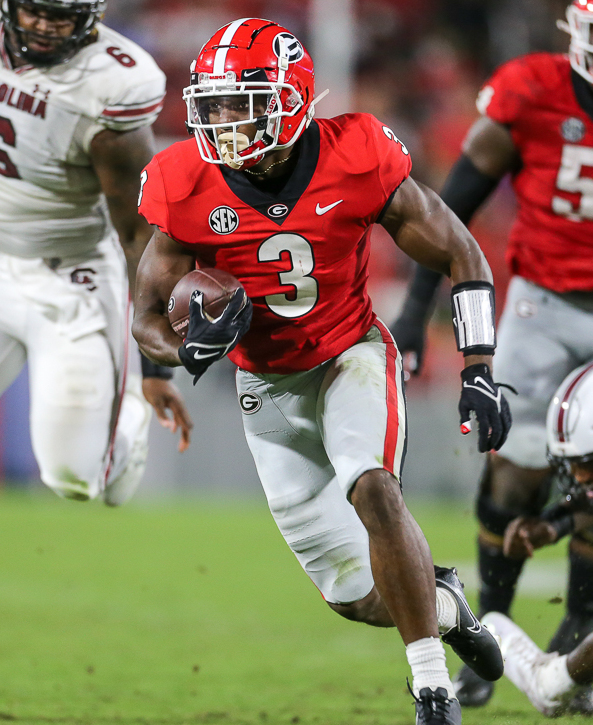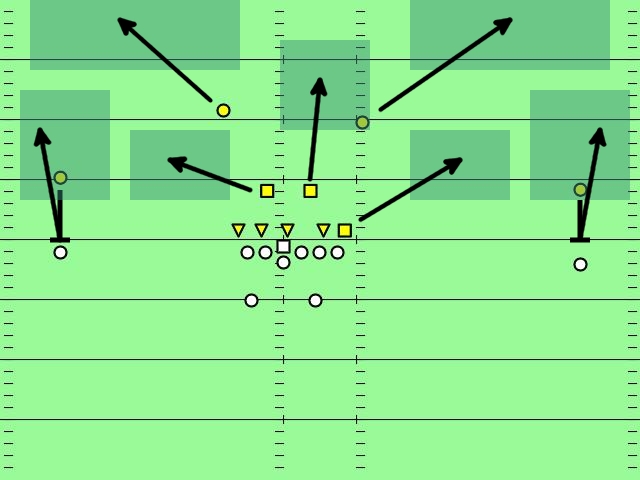|
Double Coverage
In gridiron football, double coverage is a state of defensive playcalling where two defensive players are assigned to "cover" one offensive player. This situation is often seen with standout wide receivers and running backs. It is extremely rare to have two defensive backs man-cover a single receiver. Commentators who use the term "double-coverage" almost always mean a cornerback covering a wide receiver man-to-man, with a safety playing "over the top" (typically trying to stay in front of the wide receiver's route) for deep ball assistance. Although double coverage typically involves man-to-man coverage, it can occur in zone coverage as well. Because zone coverage schemes often use six or seven defensive backs to cover the offense's five eligible receivers, one or two of these men can drop underneath a wide receiver's route while a safety or cornerback stays over the top. This can occur in such coverages as Cover 2, Cover 3 Zone coverage (also referred to as a zone defens ... [...More Info...] [...Related Items...] OR: [Wikipedia] [Google] [Baidu] |
Gridiron Football
Gridiron football,"Gridiron football" ''Encyclopædia Britannica''. Retrieved October 20, 2010. also known as North American football or, in North America, simply football, is a family of football team sports primarily played in the United States and Canada. American football, which uses 11 players, is the form played in the United States and the best known form of gridiron football worldwide, while Canadian football, which uses 12 players, predominates in Canada. Other derivative varieties include arena football, flag football and amateur games such as Touch football (American), touch and street football (American), street football. Football is played at professional gridiron football, professional, college football, collegiate, High school football, high school, semi-professional, and amateur levels. ... [...More Info...] [...Related Items...] OR: [Wikipedia] [Google] [Baidu] |
Running Backs
A running back (RB) is a member of the offensive backfield in gridiron football. The primary roles of a running back are to receive handoffs from the quarterback to rush the ball, to line up as a receiver to catch the ball, and block. There are usually one or two running backs on the field for a given play, depending on the offensive formation. A running back may be a halfback (in certain contexts also referred to as a "tailback" — see below), a wingback or a fullback. A running back will sometimes be called a "feature back" if he is the team's starting running back. Halfback/tailback The halfback (HB) or tailback (TB) position is responsible for carrying the ball on the majority of running plays, and may frequently be used as a receiver on short (or sometimes long, depending on the system) passing plays. In the modern game, an effective halfback must have a blend of both quickness and agility as a runner, as well as sure hands and good vision up-fiel ... [...More Info...] [...Related Items...] OR: [Wikipedia] [Google] [Baidu] |
Defensive Backs
In gridiron football, defensive backs (DBs), also called the secondary, are the players on the defensive side of the ball who play farthest back from the line of scrimmage. They are distinguished from the other two sets of defensive players, the defensive linemen who play directly on the line of scrimmage, and the linebackers, who play in the middle of the defense, between the defensive line and the defensive backs. Among the defensive backs, there are two main types, cornerbacks, which play nearer the line of scrimmage and the sideline, whose main role is to cover the opposing team's wide receivers, and the Safety (gridiron football position), safeties, who play further back near the center of the field, and who act as the last line of defense. American defensive formations usually includes two of each, a left and right cornerback, as well as a strong safety and a free safety, with the free safety tending to play further back than the strong safety. In Canadian football, which ha ... [...More Info...] [...Related Items...] OR: [Wikipedia] [Google] [Baidu] |
Man-to-man Defense
Man-to-man defense, or man defense, is a type of defensive technique used in team sports such as American football, association football, basketball, and netball, in which each player is assigned to defend and follow the movements of a single player on offense. Often, a player guards his counterpart (e.g. center guarding center), but a player may be assigned to guard a different position. However, the strategy is not rigid, and a player might switch assignment if needed, or leave his own assignment for a moment to double team an offensive player. The term is commonly used in both men's and women's sports. The alternative to man-to-man defense is zone defense, a system of defense (as in basketball or football) in which each player guards an assigned area rather than a specified opponent. Advantages The main reasons a team would want to play man-to-man are: * More aggressive than the zone defense. ** It also allows a team's best defender to stay on a player who has to be guarded ... [...More Info...] [...Related Items...] OR: [Wikipedia] [Google] [Baidu] |
Cornerback
A cornerback (CB) is a member of the defensive backfield or secondary in gridiron football. Cornerbacks cover receivers most of the time, but also blitz and defend against such offensive running plays as sweeps and reverses. They create turnovers through hard tackles, interceptions, and deflecting forward passes. Other members of the defensive backfield include strong and free safeties. The cornerback position requires speed, agility, strength, and the ability to make rapid sharp turns. A cornerback's skill set typically requires proficiency in anticipating the quarterback, backpedaling, executing single and zone coverage, disrupting pass routes, block shedding, and tackling. Cornerbacks are among the fastest players on the field. Because of this, they are frequently used as return specialists on punts or kickoffs. Overview The cornerback’s chief responsibility is to defend against the offense's pass. The rules of American professional football and American coll ... [...More Info...] [...Related Items...] OR: [Wikipedia] [Google] [Baidu] |
Safety (gridiron Football Position)
Safety is a position in gridiron football on the American football positions#Defense, defense. The safeties are defensive backs who line up ten to fifteen yards from the line of scrimmage. There are two variations of the position: the free safety and the strong safety. Their duties depend on the defensive scheme. The defensive responsibilities of the safety and cornerback usually involve pass coverage towards the middle and sidelines of the field. While American (11-player) formations generally use two safeties, Canadian (12-player) formations generally have one safety and two Halfback (Canadian football), defensive halfbacks, a position not used in the American game. As professional and college football have become more focused on the passing game, safeties have become more involved in covering the eligible pass receivers. Safeties are the last line of defense; they are expected to be reliable tacklers, and many safeties rank among the hardest hitters in football. Safety positi ... [...More Info...] [...Related Items...] OR: [Wikipedia] [Google] [Baidu] |
Zone Defense In American Football
Zone coverage (also referred to as a zone defense) is a defense scheme in gridiron football used to protect against the pass. Zone coverage schemes require the linebackers and defensive backs to work together to cover certain areas of the field, making it difficult for the opposing quarterback to complete passes. Zone defenses will generally require linebackers to cover the short and midrange area in the middle of the field, in front of the safeties. In the case where one or two linebackers blitz, the remaining linebacker(s) expands his zone to cover the zone responsibilities of the vacating linebacker(s). Often, blitzing will leave larger holes in the pass defense, but it is a gamble the defensive coordinator wants to make to pressure the quarterback into a poor decision and hopefully an interception or at least an incompletion. Coverage shells In the following, "cover" refers to the "shell" that the defense rolls into after the snap of the ball, more specifically the number ... [...More Info...] [...Related Items...] OR: [Wikipedia] [Google] [Baidu] |
Eligible Receiver
In gridiron football, not all players on offense are entitled to receive a forward pass: only an eligible pass receiver may legally catch a forward pass, and only an eligible receiver may advance beyond the neutral zone if a forward pass crosses into the neutral zone. If the pass is received by a non-eligible receiver, it is "illegal touching" (resulting in a penalty of five yards and loss of down). If an ineligible receiver is beyond the neutral zone when a forward pass crossing the neutral zone is thrown, a foul of " ineligible receiver downfield" (resulting in a penalty of five yards, but no loss of down) is called. Each league has slightly different rules regarding who is considered an eligible receiver. College football The NCAA rulebook defines eligible receivers for college football in Rule 7, Section 3, Article 3. The determining factors are the player's position on the field at the snap and their jersey number. Specifically, any players on offense wearing numbers betwe ... [...More Info...] [...Related Items...] OR: [Wikipedia] [Google] [Baidu] |
Cover 2
Zone coverage (also referred to as a zone defense) is a defense scheme in gridiron football used to protect against the pass. Zone coverage schemes require the linebackers and defensive backs to work together to cover certain areas of the field, making it difficult for the opposing quarterback to complete passes. Zone defenses will generally require linebackers to cover the short and midrange area in the middle of the field, in front of the safeties. In the case where one or two linebackers blitz, the remaining linebacker(s) expands his zone to cover the zone responsibilities of the vacating linebacker(s). Often, blitzing will leave larger holes in the pass defense, but it is a gamble the defensive coordinator wants to make to pressure the quarterback into a poor decision and hopefully an interception or at least an incompletion. Coverage shells In the following, "cover" refers to the "shell" that the defense rolls into after the snap of the ball, more specifically the number of ... [...More Info...] [...Related Items...] OR: [Wikipedia] [Google] [Baidu] |
Cover 3
Zone coverage (also referred to as a zone defense) is a defense scheme in gridiron football used to protect against the pass. Zone coverage schemes require the linebackers and defensive backs to work together to cover certain areas of the field, making it difficult for the opposing quarterback to complete passes. Zone defenses will generally require linebackers to cover the short and midrange area in the middle of the field, in front of the safeties. In the case where one or two linebackers blitz, the remaining linebacker(s) expands his zone to cover the zone responsibilities of the vacating linebacker(s). Often, blitzing will leave larger holes in the pass defense, but it is a gamble the defensive coordinator wants to make to pressure the quarterback into a poor decision and hopefully an interception or at least an incompletion. Coverage shells In the following, "cover" refers to the "shell" that the defense rolls into after the snap of the ball, more specifically the number of ... [...More Info...] [...Related Items...] OR: [Wikipedia] [Google] [Baidu] |



